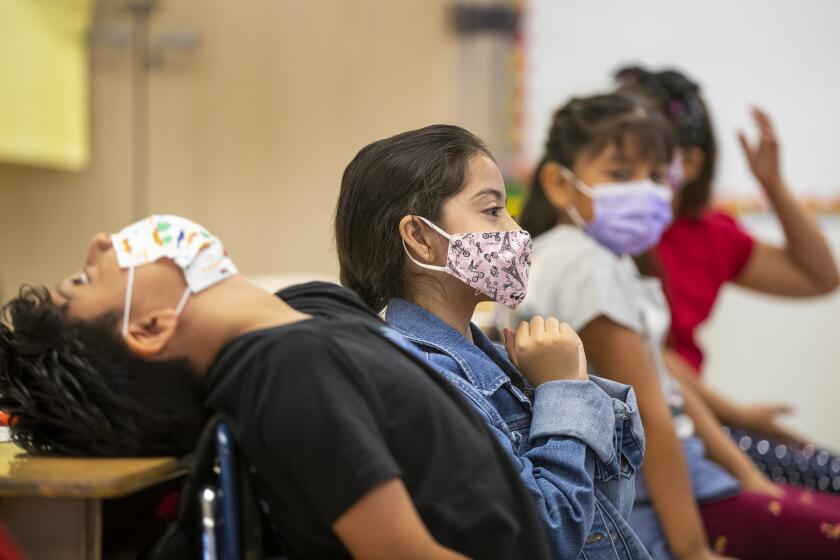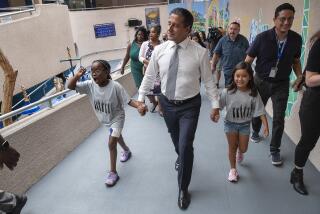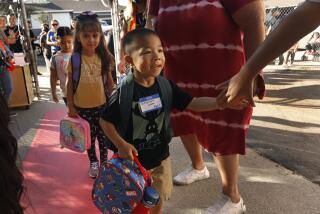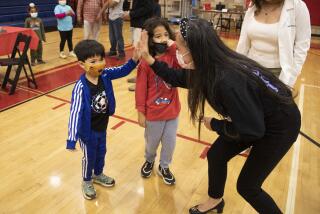LAUSD is prepping for thousands of unvaccinated students by ramping up online school

- Share via
Anticipating that thousands of Los Angeles Unified students still may not be vaccinated this fall, the Board of Education has taken the first steps toward a major expansion of remote learning, including creating as many as six new online schools that could enroll up to 15,000 students.
To date, nearly 90% of LAUSD students 12 and older have been vaccinated against COVID-19 or have obtained a rare medical exemption. But even that high compliance rate translates to about 20,000 unvaccinated students in the nation’s second-largest school district. Unvaccinated students will be barred from campuses for fall 2022 under LAUSD policies.
Additionally, district officials say they’re finding an unexpectedly large number of families who want to keep their children in independent study next year, an emerging trend education experts say they are seeing across the country with more school systems offering virtual schooling.
“Districts are hitting the reality that many families are happy with this option,” said Robin Lake, director of the Center on Reinventing Public Education. Districts are “also realizing they’ll lose enrollment if they don’t provide this option.”
Thousands of Los Angeles parents opted for independent study last fall during the surge of the Delta coronavirus variant, and stayed in the online program for the current term as Omicron raged. Many have said they fear that high coronavirus transmission rates posed safety concerns for their families.
But that deluge of students overwhelmed what had been a small, niche program, City of Angels, which typically handled about 1,800 students each year. Enrollment ballooned to15,000 students in the fall and 17,900 are currently enrolled, the largest it’s ever been.
Parents of City of Angels students have also indicated they plan to continue online. A survey of 6,280 families found that 77% want to continue online next school year, a higher rate than the district anticipated, LAUSD Chief of Schools David Baca said. It’s become clear that the district needs to create the infrastructure to sustain the program, he said.
Interim Supt. Megan K. Reilly acknowledged the program would not be for everyone but would address the needs of families who are seeking a long-term remote option. Reilly has repeatedly said that schools remain safe with layered coronavirus safety measures, including masking and a staff vaccination mandate, but establishing the online schools would prepare the district for future emergencies, such as another coronavirus surge.
“We’re trying to be as forward thinking as possible, for whatever kind of alternative we get challenged with,” Reilly said. “I do think we should still be prepared for a next variant or some other circumstance, and make sure we’re providing the best quality.”
Late Tuesday night, the board voted to authorize the district to apply for so-called county-district-school codes from the state, which assigns a unique number to a school for data keeping and other tracking, a number required for all new schools. District officials said they will later decide whether they will need all six online schools, but are aiming to open enrollment in March.
In discussing the issue, several school board members expressed interest — and in one case wariness — in pursuing the idea not just as a pandemic response, but also as an innovative digital extension of school choice — and as an offering that could bolster plummeting enrollment.
“If we build this, we should recruit [students], and it’s potentially an interesting way to get enrollment,” said board member Nick Melvoin. “We do have the resources to invest in virtual programs the way other districts don’t, so we should play to those strengths.”
But board member George McKenna, the lone no vote, was not convinced. He expressed concern that the expansion of online education could lead to student isolation and would not address the digital divide in which the families of low-income students do not have reliable internet and at-home technology.
“Everyone doesn’t have the same access, so I see a cultural and even a socioeconomic divide that’s going to take place, where people don’t have the same access,” McKenna said.
Under the nascent plan, each online school will have a distinct theme, and officials pledge to look to parents and teachers on how to shape the program. But few details were discussed with board members. Several board members said any plan that comes to them for approval should show how learning services — including those for special needs students, social-emotional development and targeted academics aimed at closing achievement gaps — will be woven into the program.
The district projects that each online school will have up to 2,500 students. Each will have a principal, three assistant principals, two academic counselors, and clerical and administrative staff. The total cost of all six schools will be about $16.2 million.
School costs are typically covered by state funding generated by enrollment, and the district intends to cover non-teacher staffing and resource costs with federal COVID-19 relief funds for the following two school years, a board report stated.
The creation of the schools will be taken over by incoming Supt. Alberto Caravalho, whose first day as schools chief is Monday.
Several education experts say the decision to invest in a robust online option is a wise move to retain enrollment and serve the needs of constituents.
“It’s clear that there’s a large number of families out there who want this option for their kids,” said Pedro Noguera, dean of the USC Rossier School of Education. “Anything they can do to keep kids in the system would be helpful.”
The district faces the challenge of creating a high-quality virtual program that will serve students long term, Noguera said, noting that the pandemic forced some districts to create quickly built virtual learning programs that did not always work. “We’re going to be living with virtually learning. This is the new normal.”
A recent survey, the American School District Panel, found that about 20% of school districts intend to move forward with a virtual option, said Lake, whose organization partnered with the Rand Corp. to conduct the survey.
She said districts are thinking about permanent online learning for two reasons.
“There’s always some portion of students who need a virtual option for life circumstances that prevent them from being at school,” Lake said. “The other factor is to be resilient to any future disruptions that come along.... If there was ever a time we need diverse solutions, it’s now.”
Antonella Guerrero, a resident of Canoga Park, said she opted to send her 12-year-old to a virtual charter school after struggling to get her son into City of Angels classes back in August. The district was not prepared for the massive onslaught of enrollment, and disorganization and lack of resources beset the early months. Students with disabilities faced barriers to accommodations and services as required under federal law.
When Guerrero could not reach LAUSD administrators for help, she enrolled her son in the California Connections Academy. The sixth-grader enjoys the flexibility and independence of online classes, she said.
If the Los Angeles school district offers a more robust online school next year, Guerrero said, she would consider bringing him back to LAUSD to make the eventual return to in-person classes easier.
For the current school year, many parents chose independent study out of safety concerns — not wanting to expose their children and other family members to the coronavirus. But district officials believe most of the increased demand will come from families not willing to abide by the board’s COVID-19 vaccine mandate for students.
The school board approved its mandate in September — one of only a handful of school systems in the state to do so — and set a Jan. 10 deadline. Unvaccinated students were to be moved to the independent study.
But as the deadline approached, the school board voted to delay enforcement to fall 2022, citing the harms of disrupting learning for so many students — some 28,000 who had not complied with the policy and those left on campus.
The next step for schools is under discussion as indoor masking set to ease on Feb. 15 in many settings in California.
A representative of United Teachers Los Angeles expressed reservations about the planning for the virtual schools during public comments.
While an expanded online option is desirable and needed, the district has not provided a plan on how the six online schools would operate, what students would be eligible or who would be prioritized, and how staff would be recruited, said UTLA representative Ingrid Gunnell.
“The district has not meaningfully engaged the community’s labor partners or other stakeholders,” Gunnell said. She urged the district to present a clear plan of the program and “show us how this program will be designed with equity in mind to support our most vulnerable students and prioritize those that most need an online option.”
It remains to be seen how proposed state legislation that would require all California students be vaccinated against COVID-19 will affect online enrollment. State Sen. Richard Pan (D-Sacramento) has proposed legislation that aims to add COVID-19 vaccines to the state’s list of required immunizations for children attending K-12 schools, supporting the mandates of LAUSD and other school districts.
Times staff writer Howard Blume contributed to this report.
More to Read
Sign up for Essential California
The most important California stories and recommendations in your inbox every morning.
You may occasionally receive promotional content from the Los Angeles Times.
















